2011 INFINITI QX56 BATTERY
[x] Cancel search: BATTERYPage 5454 of 5598

WT-4
< PRECAUTION >
PRECAUTIONS
5. When the repair work is completed, re-connect both battery cables. With the brake pedal released, turn
the push-button ignition switch from ACC position to ON position, then to LOCK position. (The steering
wheel will lock when the push-button igniti on switch is turned to LOCK position.)
6. Perform self-diagnosis check of all control units using CONSULT-III.
Service Notice or Precautions for TPMSINFOID:0000000006225485
Low tire pressure warning lamp blinks for 1min, then turns ON when occurring any malfunction except low tire pressure. Erase the self-diagnosis memories for low tire pressure warning control unit, or register the ID
to turn low tire pressure warning lamp OFF. For ID registration, refer to WT-29, "
Work Procedure".
ID registration is required when replacing or rotating wheel s, replacing transmitter or low tire pressure warn-
ing control unit. Refer to WT-29, "
Work Procedure".
Replace grommet seal, valve core and cap of transmitter in TPMS, when replacing each tire by reaching the
wear limit. Refer to WT-66, "
Exploded View".
For tire inflation indicator function, refer to the following.
- When inflating the tires, park the vehicle in the safe area and ensure the safety of the working area.
- Read and understand the tire inflation indicator function prior to use.
- Inflate the tires one at a time.
- If there is no response for approximately 15 seconds or mo re after inflating the tires, cancel the use of the
tire inflation indicator function or move the vehicle approximately 1 m (3.2 ft) backward or forward to try
again. The air filler pressure may be weak or out of service area.
- Despite the high-precision TPMS pressure sensor, an i ndicated value may differ from that of the pressure
gauge.
- Air pressure is measured rather high due to the rise in tire air temperature after driving.
- If TPMS is malfunctioning, the tire inflation indicator is unusable.
Service Notice or Precautions for Road WheelINFOID:0000000006225486
Genuine NISSAN aluminum wheel is designed for each type of vehicle. Use it on the specified vehicle only.
Use Genuine NISSAN parts for the wheel nuts.
Always use them after adjusting the wheel balance. For the balance weights, use Genuine NISSAN alumi-
num wheel weights.
Use caution when handling the aluminum wheels, because they can be easily scratched. When removing
dirt, do not use any abrasives, a wire brush, or other it ems that may scratch the coating. Use a neutral deter-
gent if a detergent is needed.
After driving on roads scattered with anti-ici ng salts, wash off the wheels completely.
When installing road wheels onto the vehicle, always wipe of f any dirt or foreign substances to prevent them
from being trapped between the contact surfaces of wheel.
Never apply oil to nut and bolt threads.
Revision: 2010 May2011 QX56
Page 5466 of 5598
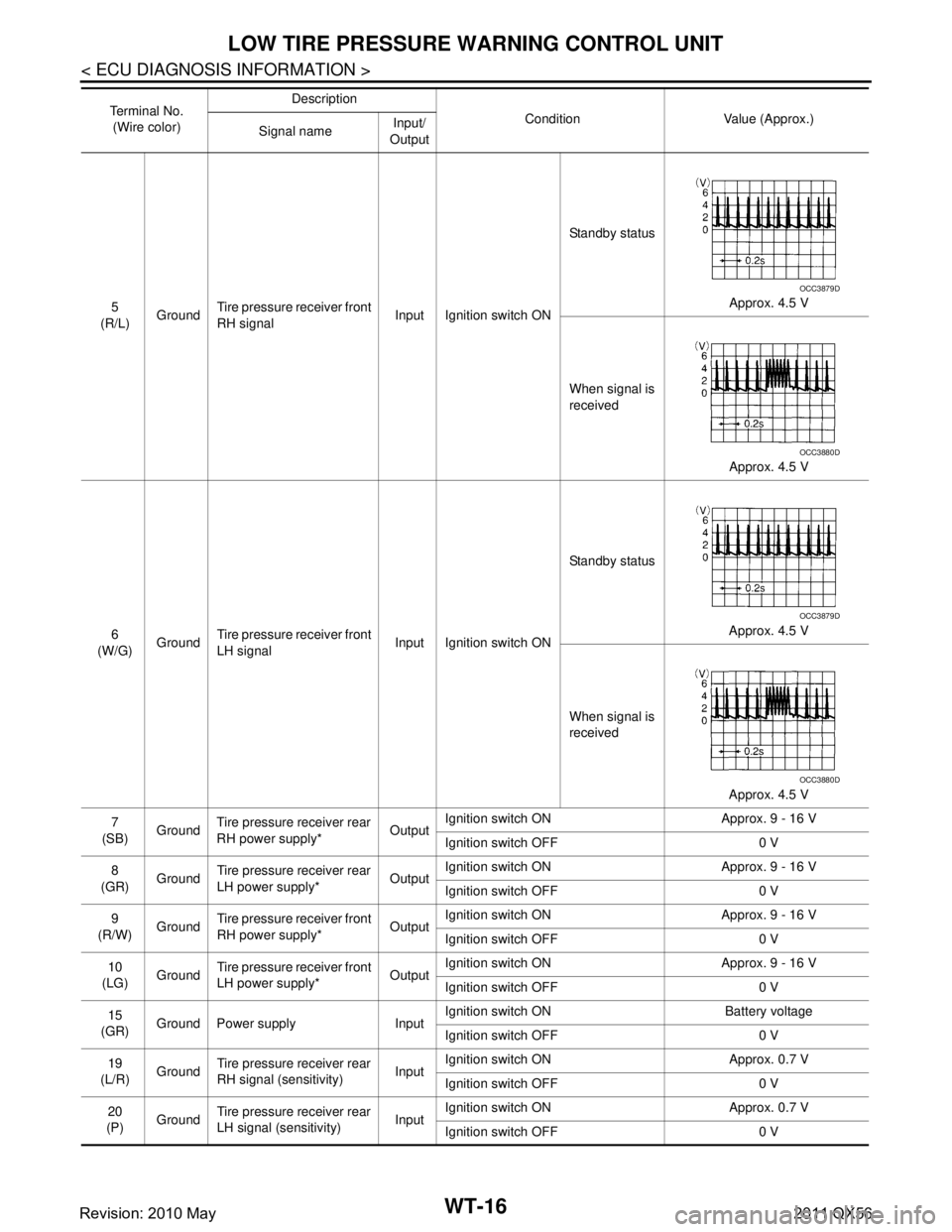
WT-16
< ECU DIAGNOSIS INFORMATION >
LOW TIRE PRESSURE WARNING CONTROL UNIT
5
(R/L) Ground
Tire pressure receiver front
RH signal Input Ignition switch ONStandby status
Approx. 4.5 V
When signal is
received Approx. 4.5 V
6
(W/G) Ground Tire pressure receiver front
LH signal
Input Ignition switch ONStandby status
Approx. 4.5 V
When signal is
received Approx. 4.5 V
7
(SB) Ground Tire pressure receiver rear
RH power supply*
OutputIgnition switch ON Approx. 9 - 16 V
Ignition switch OFF 0 V
8
(GR) Ground Tire pressure receiver rear
LH power supply*
OutputIgnition switch ON Approx. 9 - 16 V
Ignition switch OFF 0 V
9
(R/W) Ground Tire pressure receiver front
RH power supply*
OutputIgnition switch ON Approx. 9 - 16 V
Ignition switch OFF 0 V
10
(LG) Ground Tire pressure receiver front
LH power supply*
OutputIgnition switch ON Approx. 9 - 16 V
Ignition switch OFF 0 V
15
(GR) Ground Power supply Input Ignition switch ON Battery voltage
Ignition switch OFF 0 V
19
(L/R) Ground Tire pressure receiver rear
RH signal (sensitivity) InputIgnition switch ON Approx. 0.7 V
Ignition switch OFF 0 V
20
(P) Ground Tire pressure receiver rear
LH signal (sensitivity) InputIgnition switch ON Approx. 0.7 V
Ignition switch OFF 0 V
Te r m i n a l N o .
(Wire color) Description
Condition Value (Approx.)
Signal name Input/
Output
OCC3879D
OCC3880D
OCC3879D
OCC3880D
Revision: 2010 May2011 QX56
Page 5483 of 5598
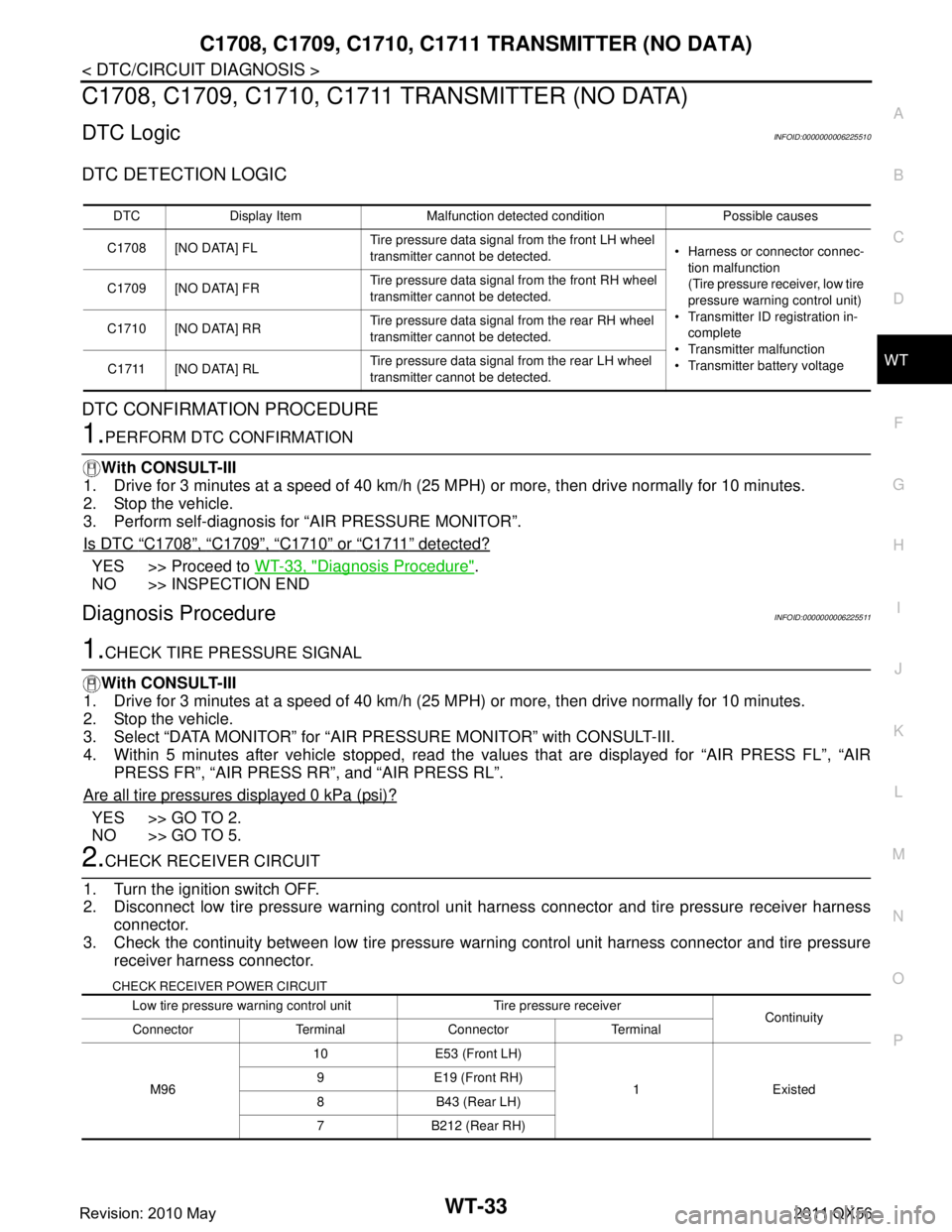
C1708, C1709, C1710, C1711 TRANSMITTER (NO DATA)
WT-33
< DTC/CIRCUIT DIAGNOSIS >
C
DF
G H
I
J
K L
M A
B
WT
N
O P
C1708, C1709, C1710, C1711 TRANSMITTER (NO DATA)
DTC LogicINFOID:0000000006225510
DTC DETECTION LOGIC
DTC CONFIRMATION PROCEDURE
1.PERFORM DTC CONFIRMATION
With CONSULT-III
1. Drive for 3 minutes at a speed of 40 km/h (25 MPH) or more, then drive normally for 10 minutes.
2. Stop the vehicle.
3. Perform self-diagnosis for “AIR PRESSURE MONITOR”.
Is DTC
“C1708”, “C1709”, “C1710” or “C1711” detected?
YES >> Proceed to WT-33, "Diagnosis Procedure".
NO >> INSPECTION END
Diagnosis ProcedureINFOID:0000000006225511
1.CHECK TIRE PRESSURE SIGNAL
With CONSULT-III
1. Drive for 3 minutes at a speed of 40 km/h (25 MPH) or more, then drive normally for 10 minutes.
2. Stop the vehicle.
3. Select “DATA MONITOR” for “AIR PRESSURE MONITOR” with CONSULT-III.
4. Within 5 minutes after vehicle stopped, read the val ues that are displayed for “AIR PRESS FL”, “AIR
PRESS FR”, “AIR PRESS RR”, and “AIR PRESS RL”.
Are all tire pressures displayed 0 kPa (psi)?
YES >> GO TO 2.
NO >> GO TO 5.
2.CHECK RECEIVER CIRCUIT
1. Turn the ignition switch OFF.
2. Disconnect low tire pressure warning control unit harness connector and tire pressure receiver harness connector.
3. Check the continuity between low tire pressure warning control unit harness connector and tire pressure
receiver harness connector.
CHECK RECEIVER POWER CIRCUIT
DTC Display Item Malfunction detected condition Possible causes
C1708 [NO DATA] FL Tire pressure data signal from the front LH wheel
transmitter cannot be detected.
Harness or connector connec-
tion malfunction
(Tire pressure re ceiver, low tire
pressure warning control unit)
Transmitter ID registration in-
complete
Transmitter malfunction
Transmitter battery voltage
C1709 [NO DATA] FR
Tire pressure data signal from the front RH wheel
transmitter cannot be detected.
C1710 [NO DATA] RR Tire pressure data signal from the rear RH wheel
transmitter cannot be detected.
C1711 [NO DATA] RL Tire pressure data signal from the rear LH wheel
transmitter cannot be detected.
Low tire pressure wa
rning control unit Tire pressure receiver
Continuity
Connector Terminal Connector Terminal
M96 10 E53 (Front LH)
1 Existed
9 E19 (Front RH)
8 B43 (Rear LH)
7 B212 (Rear RH)
Revision: 2010 May2011 QX56
Page 5501 of 5598

POWER SUPPLY AND GROUND CIRCUITWT-51
< DTC/CIRCUIT DIAGNOSIS >
C
DF
G H
I
J
K L
M A
B
WT
N
O P
POWER SUPPLY AND GROUND CIRCUIT
Diagnosis ProcedureINFOID:0000000006225530
1.CHECK FUSE/FUSIBLE LINK
1. Turn the ignition switch OFF.
2. Check for fusing of the fuse and fusible link at the low tire pressure warning control unit.
- Check the 10 A fuse [No. 3 in fuse block (J/B)]
Is the inspection result normal?
YES >> GO TO 2.
NO >> Repair or replace error-detected parts.
2.CHECK LOW TIRE PRESSURE WARNING CONTROL UNIT POWER SUPPLY CIRCUIT
1. Disconnect the low tire pressure warning control unit harness connector.
2. Turn the ignition switch ON. CAUTION:
Never start engine.
3. Check the voltage between the low tire pressure warning control unit and ground.
4. Turn the ignition switch OFF.
5. Check the voltage between the low tire pressure warning control unit and ground.
Is the inspection result normal?
YES >> GO TO 3.
NO >> Check the following. If any items are damaged, repair or replace damaged parts. Harness for short or open between ignition switch and low tire pressure warning control unit har-ness connector
Battery voltage.
3.CHECK LOW TIRE PRESSURE WARNI NG CONTROL UNIT GROUND CIRCUIT
1. Turn the ignition switch OFF.
2. Check the continuity between the low tire pressure warning control unit harness connector and ground.
- Also check harness for short to ground and short to power.
Is the inspection result normal?
YES >> INSPECTION END
NO >> Repair open circuit or short to ground or short to power in harness or connectors.
Low tire pressure warning control unit —Voltage
Connector Terminal
M96 15 Ground Battery voltage
Low tire pressure warning control unit —Voltage
Connector Terminal
M96 15 Ground 0 V
Low tire pressure warning control unit —Continuity
Connector Terminal
M96 32 Ground Existed
Revision: 2010 May2011 QX56
Page 5505 of 5598
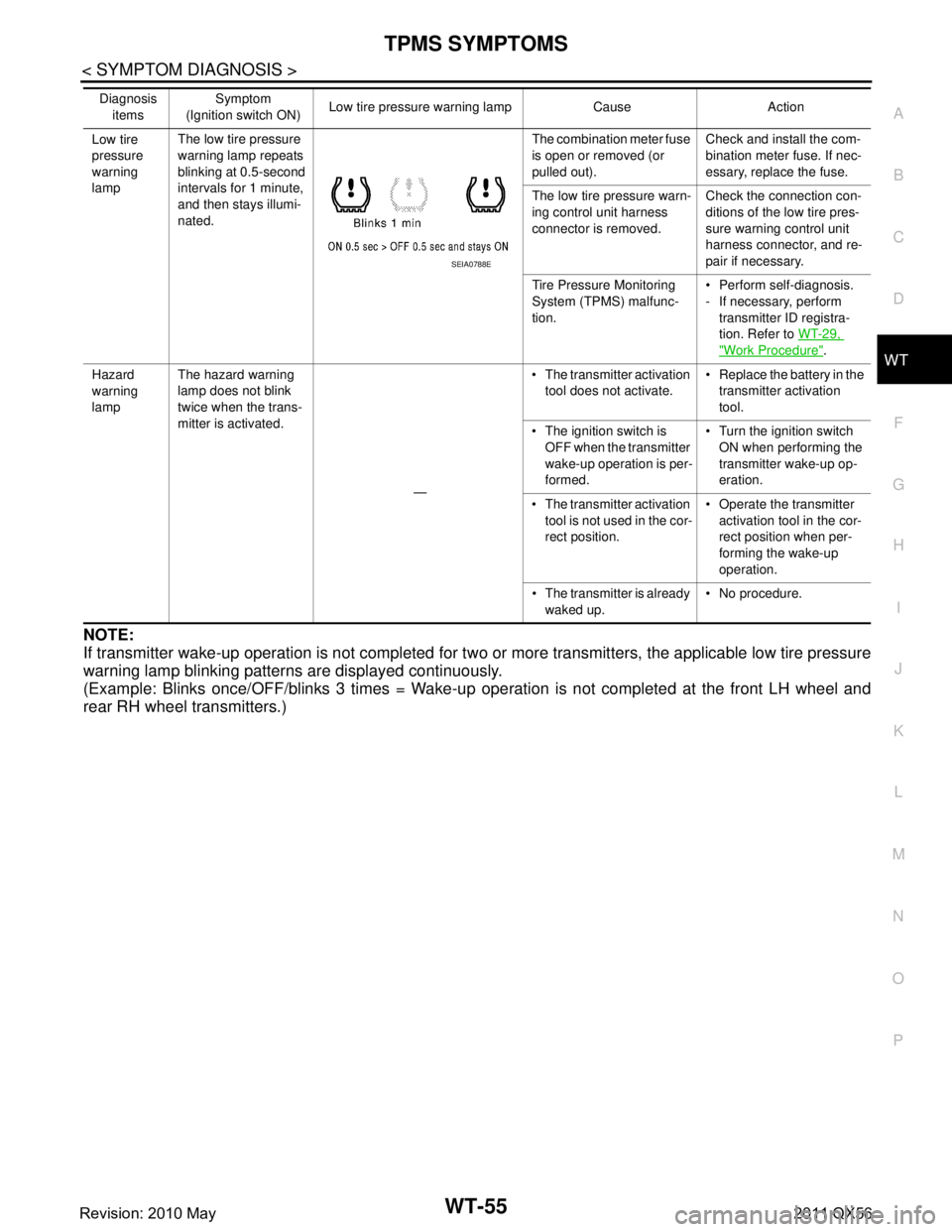
TPMS SYMPTOMSWT-55
< SYMPTOM DIAGNOSIS >
C
DF
G H
I
J
K L
M A
B
WT
N
O P
NOTE:
If transmitter wake-up operation is not completed for tw o or more transmitters, the applicable low tire pressure
warning lamp blinking patterns are displayed continuously.
(Example: Blinks once/OFF/blinks 3 times = Wake-up operation is not completed at the front LH wheel and
rear RH wheel transmitters.)
Low tire
pressure
warning
lamp The low tire pressure
warning lamp repeats
blinking at 0.5-second
intervals for 1 minute,
and then stays illumi-
nated. The combination meter fuse
is open or removed (or
pulled out).
Check and install the com-
bination meter fuse. If nec-
essary, replace the fuse.
The low tire pr essure warn-
ing control unit harness
connector is removed. Check the connection con-
ditions of the low tire pres-
sure warning
control unit
harness connector, and re-
pair if necessary.
Tire Pressure Monitoring
System (TPMS) malfunc-
tion. Perform self-diagnosis.
- If necessary, perform
transmitter ID registra-
tion. Refer to WT-29,
"Work Procedure".
Hazard
warning
lamp The hazard warning
lamp does not blink
twice when the trans-
mitter is activated.
— The transmitter activation
tool does not activate. Replace the battery in the
transmitter activation
tool.
The ignition switch is OFF when the transmitter
wake-up operation is per-
formed. Turn the ignition switch
ON when performing the
transmitter wake-up op-
eration.
The transmitter activation tool is not used in the cor-
rect position. Operate the transmitter
activation tool in the cor-
rect position when per-
forming the wake-up
operation.
The transmitter is already waked up. No procedure.
Diagnosis
items Symptom
(Ignition switch ON) Low tire pressure wa
rning lamp Cause Action
SEIA0788E
Revision: 2010 May2011 QX56
Page 5510 of 5598
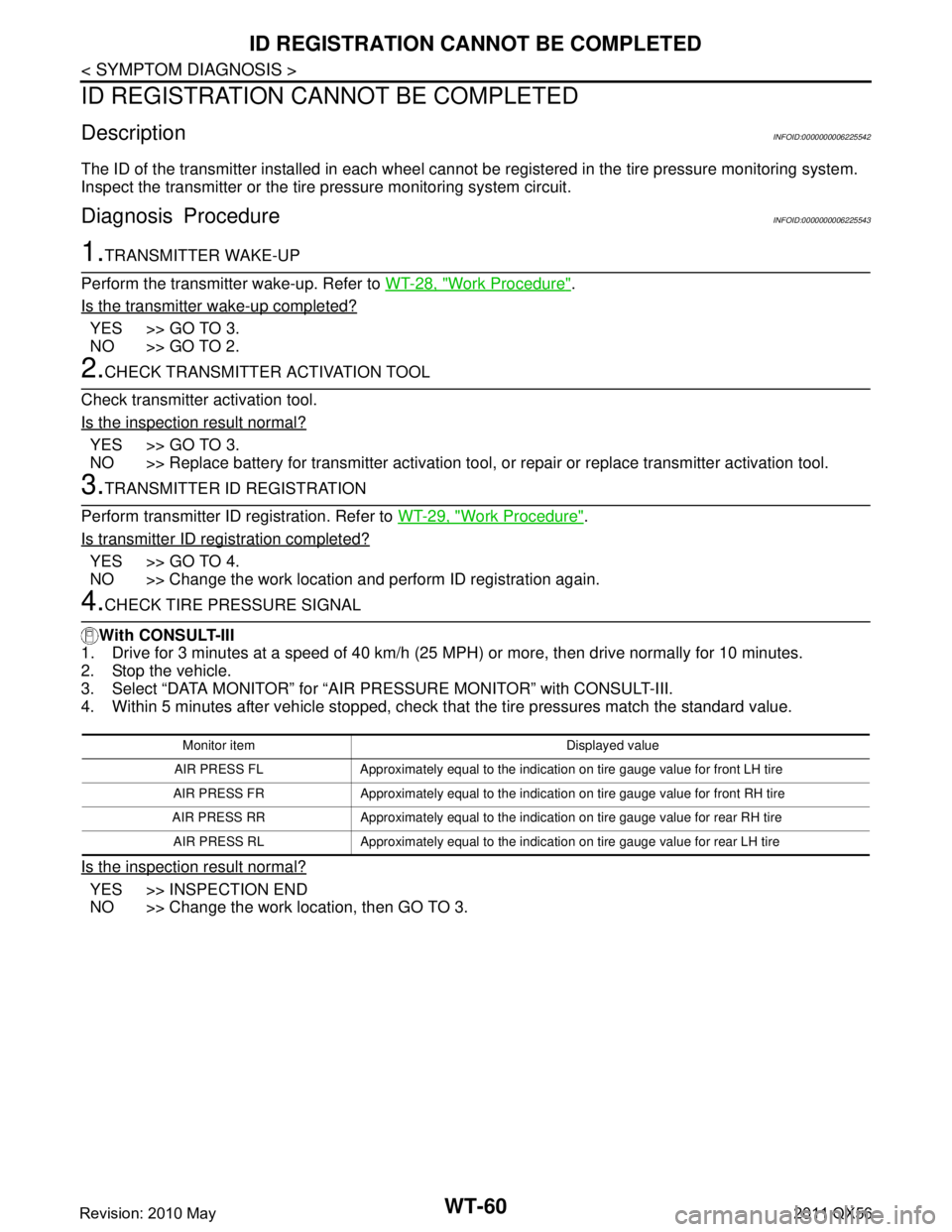
WT-60
< SYMPTOM DIAGNOSIS >
ID REGISTRATION CANNOT BE COMPLETED
ID REGISTRATION CANNOT BE COMPLETED
DescriptionINFOID:0000000006225542
The ID of the transmitter installed in each wheel cannot be registered in the tire pressure monitoring system.
Inspect the transmitter or the tire pressure monitoring system circuit.
Diagnosis ProcedureINFOID:0000000006225543
1.TRANSMITTER WAKE-UP
Perform the transmitter wake-up. Refer to WT-28, "
Work Procedure".
Is the transmitter wake-up completed?
YES >> GO TO 3.
NO >> GO TO 2.
2.CHECK TRANSMITTER ACTIVATION TOOL
Check transmitter activation tool.
Is the inspection result normal?
YES >> GO TO 3.
NO >> Replace battery for transmitter activation tool, or repair or replace transmitter activation tool.
3.TRANSMITTER ID REGISTRATION
Perform transmitter ID registration. Refer to WT-29, "
Work Procedure".
Is transmitter ID registration completed?
YES >> GO TO 4.
NO >> Change the work location and perform ID registration again.
4.CHECK TIRE PRESSURE SIGNAL
With CONSULT-III
1. Drive for 3 minutes at a speed of 40 km/h (25 MPH) or more, then drive normally for 10 minutes.
2. Stop the vehicle.
3. Select “DATA MONITOR” for “AIR PR ESSURE MONITOR” with CONSULT-III.
4. Within 5 minutes after vehicle stopped, check t hat the tire pressures match the standard value.
Is the inspection result normal?
YES >> INSPECTION END
NO >> Change the work location, then GO TO 3.
Monitor item Displayed value
AIR PRESS FL Approximately equal to the indication on tire gauge value for front LH tire
AIR PRESS FR Approximately equal to the indica tion on tire gauge value for front RH tire
AIR PRESS RR Approximately equal to the indica tion on tire gauge value for rear RH tire
AIR PRESS RL Approximately equal to the indicati on on tire gauge value for rear LH tire
Revision: 2010 May2011 QX56
Page 5520 of 5598

WW-1
DRIVER CONTROLS
C
DE
F
G H
I
J
K
M
SECTION WW
A
B
WW
N
O P
CONTENTS
WIPER & WASHER
PRECAUTION ................ ...............................3
PRECAUTIONS .............................................. .....3
Precaution for Supplemental Restraint System
(SRS) "AIR BAG" and "SEAT BELT PRE-TEN-
SIONER" ............................................................. ......
3
Precaution Necessary for Steering Wheel Rota-
tion after Battery Disconnect .....................................
3
Precaution for Procedure without Cowl Top Cover ......4
SYSTEM DESCRIPTION ..............................5
COMPONENT PARTS ................................... .....5
Component Parts Location .................................. ......5
Component Description ............................................6
Washer Switch ..........................................................6
SYSTEM ..............................................................7
FRONT WIPER AND WASHER SYSTEM ............. ......7
FRONT WIPER AND WASHER SYSTEM : Sys-
tem Diagram ..............................................................
7
FRONT WIPER AND WASHER SYSTEM : Sys-
tem Description .........................................................
7
FRONT WIPER AND WASHER SYSTEM : Fail-
safe ...........................................................................
9
REAR WIPER AND WASHER SYSTEM ............... ....10
REAR WIPER AND WASHER SYSTEM : System
Diagram ...................................................................
10
REAR WIPER AND WASHER SYSTEM : System
Description ..............................................................
10
REAR WIPER AND WASHER SYSTEM :
Fail Safe .................................................................
12
HEADLAMP WASHER SYSTEM .......................... ....12
HEADLAMP WASHER SYSTEM : System Dia-
gram ........................................................................
13
HEADLAMP WASHER SYSTEM : System De-
scription ...................................................................
13
DIAGNOSIS SYSTEM (BCM) ............................14
COMMON ITEM ..................................................... ....14
COMMON ITEM : CONSULT-III Function (BCM -
COMMON ITEM) .....................................................
14
WIPER .................................................................... ....15
WIPER : CONSULT-III Function (BCM - WIPER) ....15
DIAGNOSIS SYSTEM (IPDM E/R) ...................18
Diagnosis Description ..............................................18
CONSULT-III Function (IPDM E/R) .........................20
ECU DIAGNOSIS INFORMATION ..............23
BCM, IPDM E/R .................................................23
List of ECU Reference ......................................... ....23
WIRING DIAGRAM ......................................24
WIPER AND WASHER SYSTEM .....................24
Wiring Diagram .................................................... ....24
BASIC INSPECTION ...................................33
DIAGNOSIS AND REPAIR WORKFLOW ........33
Work Flow ............................................................ ....33
DTC/CIRCUIT DIAGNOSIS .........................35
WIPER AND WASHER FUSE ...........................35
Diagnosis Procedure ........................................... ....35
FRONT WIPER MOTOR LO CIRCUIT ..............36
Component Function Check ....................................36
Diagnosis Procedure ...............................................36
FRONT WIPER MOTOR HI CIRCUIT ...............37
Component Function Check ....................................37
Diagnosis Procedure ...............................................37
FRONT WIPER AUTO STOP SIGNAL CIR-
CUIT ..................................................................
38
Component Function Check ....................................38
Diagnosis Procedure ...............................................38
Revision: 2010 May2011 QX56
Page 5522 of 5598
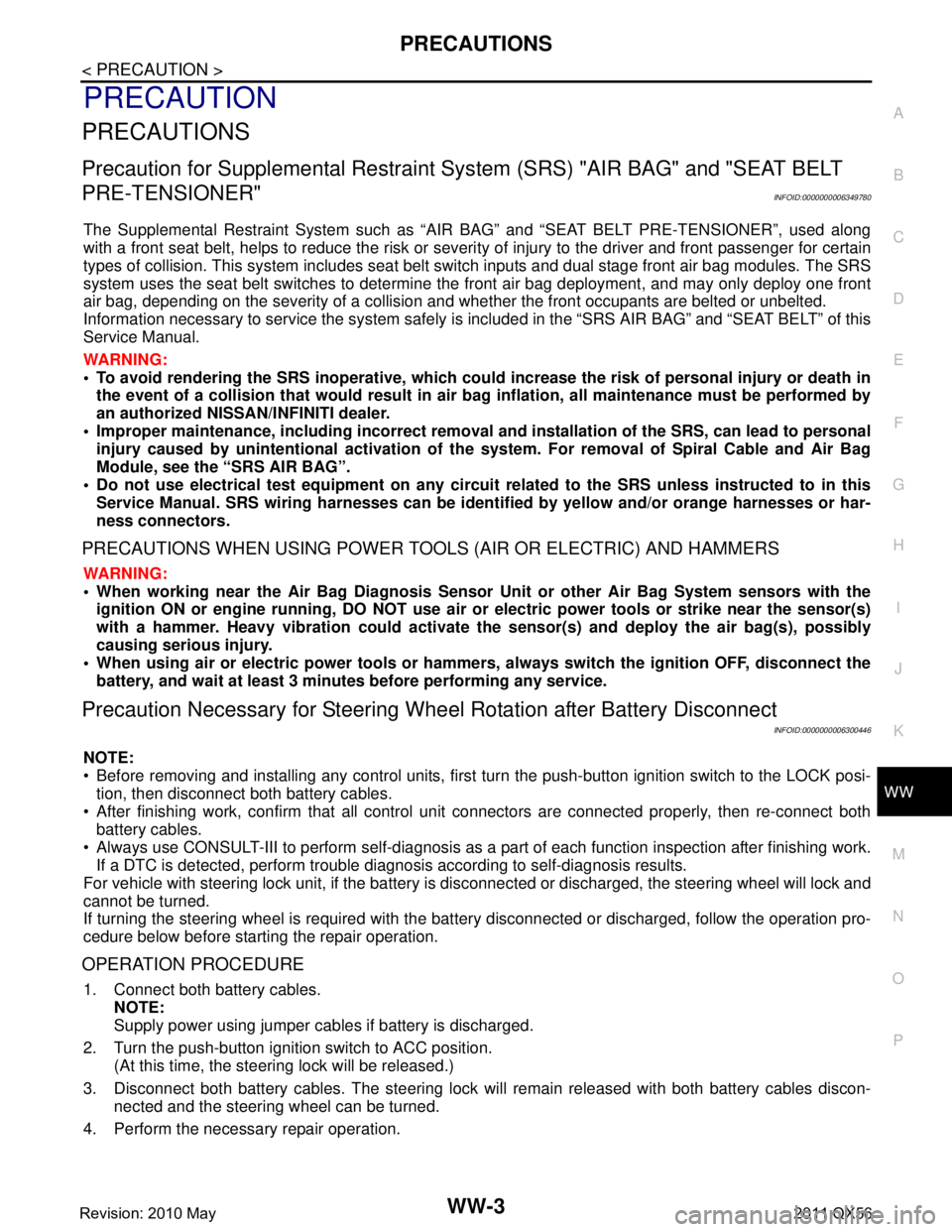
PRECAUTIONSWW-3
< PRECAUTION >
C
DE
F
G H
I
J
K
M A
B
WW
N
O P
PRECAUTION
PRECAUTIONS
Precaution for Supplemental Restraint System (SRS) "AIR BAG" and "SEAT BELT
PRE-TENSIONER"
INFOID:0000000006349780
The Supplemental Restraint System such as “A IR BAG” and “SEAT BELT PRE-TENSIONER”, used along
with a front seat belt, helps to reduce the risk or severi ty of injury to the driver and front passenger for certain
types of collision. This system includes seat belt switch inputs and dual stage front air bag modules. The SRS
system uses the seat belt switches to determine the front air bag deployment, and may only deploy one front
air bag, depending on the severity of a collision and whether the front occupants are belted or unbelted.
Information necessary to service the system safely is included in the “SRS AIR BAG” and “SEAT BELT” of this
Service Manual.
WARNING:
• To avoid rendering the SRS inoper ative, which could increase the risk of personal injury or death in
the event of a collision that would result in air ba g inflation, all maintenance must be performed by
an authorized NISSAN/INFINITI dealer.
Improper maintenance, including in correct removal and installation of the SRS, can lead to personal
injury caused by unintentional act ivation of the system. For removal of Spiral Cable and Air Bag
Module, see the “SRS AIR BAG”.
Do not use electrical test equipm ent on any circuit related to the SRS unless instructed to in this
Service Manual. SRS wiring harnesses can be identi fied by yellow and/or orange harnesses or har-
ness connectors.
PRECAUTIONS WHEN USING POWER TOOLS (AIR OR ELECTRIC) AND HAMMERS
WARNING:
When working near the Air Bag Diagnosis Sensor Unit or other Air Bag System sensors with the
ignition ON or engine running, DO NOT use air or electric power tools or strike near the sensor(s)
with a hammer. Heavy vibration could activate the sensor(s) and deploy the air bag(s), possibly
causing serious injury.
When using air or electric power tools or hammers , always switch the ignition OFF, disconnect the
battery, and wait at least 3 minutes before performing any service.
Precaution Necessary for Steering Wh eel Rotation after Battery Disconnect
INFOID:0000000006300446
NOTE:
Before removing and installing any control units, first tu rn the push-button ignition switch to the LOCK posi-
tion, then disconnect both battery cables.
After finishing work, confirm that all control unit connectors are connected properly, then re-connect both
battery cables.
Always use CONSULT-III to perform self-diagnosis as a part of each function inspection after finishing work.
If a DTC is detected, perform trouble diagnos is according to self-diagnosis results.
For vehicle with steering lock unit, if the battery is disconnected or discharged, the steering wheel will lock and
cannot be turned.
If turning the steering wheel is required with the batte ry disconnected or discharged, follow the operation pro-
cedure below before starting the repair operation.
OPERATION PROCEDURE
1. Connect both battery cables. NOTE:
Supply power using jumper cables if battery is discharged.
2. Turn the push-button ignition switch to ACC position. (At this time, the steering lock will be released.)
3. Disconnect both battery cables. The steering lock wil l remain released with both battery cables discon-
nected and the steering wheel can be turned.
4. Perform the necessary repair operation.
Revision: 2010 May2011 QX56